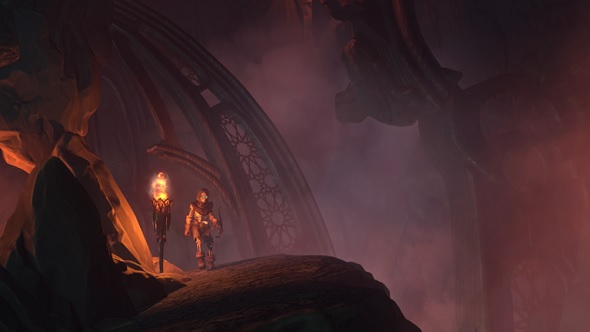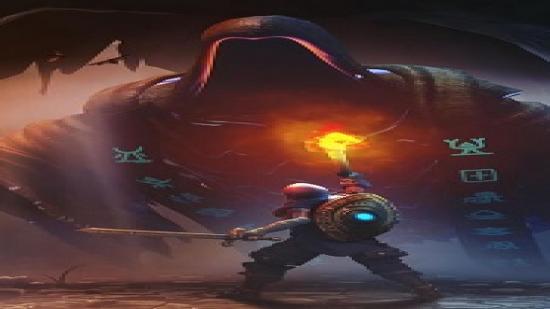Underworld Ascendant opens with a problem: you must escape from a series of chambers armed with absolutely no weapons. This area is designed as an “un-training level,” with the intent of teaching you how important physical properties are.
“We found in testing that if you give people a sword early they want to solve everything with the sword,” Joe Fielder, game writer and director, says. Without a sword, you are forced to use your intellect, which is where Underworld Ascendant passes over the boundary between being an RPG and an immersive sim.
Underworld Ascendant feels like more of an immersive sim than Deus Ex.
But, like with its swordless opening, Underworld Ascendant is doing immersive sims differently. The first return visit to the Stygian Abyss in over 25 years promises not only to remind us of how the Underworld games birthed this ambitious genre in the first place, but also demonstrate that you can do them without being hooked up to a publisher’s seemingly ceaseless cash flow.

The independent studio behind Underworld Ascendant are Otherside Entertainment. A team of immersive sim veterans with the likes of System Shock, Thief, and BioShock Infinite under their belts, their names are likely to inspire delight in the hearts of 30-somethings who grew up during the creative explosion of the 1990s. But these days the world of the Stygian Abyss means nothing to those who grew up in the lands of Skyrim and Dunwall. Otherside are not worried about that, though.
“People who have never played Ultima Underworld have likely played games that were influenced by it,” Tim Stellmach, lead designer of Underworld Ascendant, says. “I think people will recognise a lot of what we’re doing in terms of what they’ve seen in some of the original games’ successors.”
Ultima Underworld was something to behold when it released in 1992. A first-person, 3D RPG that allowed you to freely explore the dungeon-like realm of the Stygian Abyss, it was, without any sense of hyperbole, a revolution in PC gaming. There had been nothing like it before but there would be dozens like it after. Many colossally successful videogames can trace their lineage back to it – most notably, every game made by Bethesda Softworks. But while Stellmach and his team admire the likes of The Elder Scrolls and Dishonored, they have some of their own ideas for the genre.

“The direction that we think that genre would have gone if we’d continued doing Underworld games back in the day is is not necessarily the same thing as the interpretations other people have given to it,” Stellmach says. “The systems-based design, where you’re putting the player in control of how they navigate and get through challenges, has not been taken as far as we’d want to take it.”
A veteran developer of Looking Glass Studios and the original Underworld games, Stellmach has a few ideas of where he’d have pushed immersive sims next. Those ideas are finally manifesting in Underworld Ascendant. “We’re going deeper into those elements in this game, and everything that we’re going to be making going forward,” he says.
Fielder believes that Underworld-influenced games have developed in pursuit of expansive landscapes, and in the process have created static-feeling worlds. “You’ll return to areas and you’re lucky if there’s a repopulation of enemies there,” he says. “We are instead trying to make a smaller footprint, but one that’s infinitely replayable with varying enemies.”

The Stygian Abyss may be smaller than other immersive sim worlds, but the way it changes over time should provide new surprises. “There’s a degrading world state,” Fielder explains. “As you play, creatures from the lower depths start to emerge. We have outcasts that are building different structures throughout the levels. Basically every time you return to an area it could be radically different.”
With each repeat visit to a locale you will bring with you a new suite of tools and abilities, thanks to the levelling up achieved during your time away. Combining these abilities with newly-built structures may, for example, reveal different movement options through an area. “It’s pretty new and not a lot of people are taking advantage of this sort of evolving world,” Fielder says.
Beyond clever use of a smaller collection of areas, Otherside are producing problems with unscripted solutions in order to enhance Ascendant’s replay value and stay within the lines of their smaller budget. While a puzzle in the Abyss may have several outcomes considered by the team during development, the physics-based design of every system means that the solution is simply what you can make successfully work, rather than anything prescribed.
One example of this, located in the “untraining level,” is a lever located across a chasm which must be flipped to activate a portcullis and release you from your prison. “In this room in particular there were more [solutions] than we thought,” Fielder says. “We found players could use a spell from a previous room to bind a crate, punch it, push it out into the gap, jump on the crate, and jump across to reach the lever themselves. We’d never seen that before, but it totally makes sense.
“Another player found that by stacking a crate and standing on top of it they were able to throw a heavier object across the gap,” he says.
“Some of the objects were a little too heavy to throw across the gap,” Stellmach adds. “But if you broke them their fragments were light enough to throw across. Lots of different solutions to that one problem.”
Creating this kind of freeform experience is not easy. “You have to be willing to give up a certain amount of control, which is not comfortable as a design discipline,” Stellmach says. “The way that you think about the player’s journey is very different. Instead of thinking in terms of specific sequences of events, you have to think much more in terms of challenging scenarios and relevant toolsets that you unveil to the player. It’s more the kind of mindset I would take as dungeon master in a pen-and-paper RPG.”

Following through on this kind of design philosophy is not simple when you don’t have the financial backing of a huge publisher like Bethesda. As such, Otherside have had to apply themselves to their ideas with careful precision. “The overall approach we have to the player experience is focusing on trying to deepen and enrich the game systems,” Stellmach says. “That’s something you can do with the right people who have a lot of expertise with that kind of system design, and in a context where you can recognise some opportunities that other games have left on the table.
“If you compare that to the trajectory of a lot of mainstream games, those teams and those budgets are largely driven by content production, which tries to deliver a lot of value in terms of tourism,” he explains. “You look at a Skyrim or a Fallout and there is so much of that in what they’re trying to do. [Making huge worlds] is something that you can’t just throw smarter people at, you have to throw more people at it. So you really have to take a different approach as an indie developer.”
Underworld Ascendant features a much smaller world than the expanses of Cyrodiil or the city of Dunwall, then. But what it lacks in breadth it most certainly makes up for in depth of systems – fitting for a game set in the actual abyss. It would appear that not a single room in the caverns of the underworld should be taken at face value. It’s an exciting new direction for immersive sims and, considering the legacies of the developers lowering us into the depths, it should prove to be a worthwhile one.
